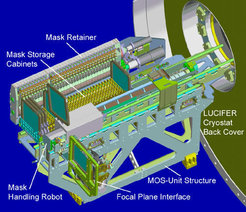LUCI
Short Description:
LUCI is the near-infrared instrument for the Large Binocular Telescope (LBT). LUCI operates in the 0.9 - 2.5 µm spectral range using a 2048 x 2048 element Hawaii II detector array from Rockwell and provides imaging and spectroscopic capabilities in seeing- and diffraction limited modes. In its focal plane area, long-slit and multi-slit masks can be installed for single- and multi-object spectroscopy. A fixed collimator produces an image of the entrance aperture in which either a mirror (for imaging) or a grating can be positioned. Three camera optics with numerical apertures of 1.8, 3.75 and 30 provide image scales of 0.25, 0.12, and 0.015 arcsec/detector element for wide field, seeing-limited and diffraction-limited observations. Like all infrared instruments, LUCI is operated at cryogenic temperatures, and is therefore enclosed in a cryostat of 1.6 m diameter and 1.6 m height, and cooled down to about -200 C by two closed cycle coolers.
(The name of the instrument was officially changed from LUCIFER to LUCI in 2012.)
Project Type:
Instrumentation for ground-based telescope
MPE Involvement:
LUCI is built by a German consortium led by the Landessternwarte in Heidelberg.
MPE contributes the multi-object spectrograph unit that handles the slit masks for LUCI1 and LUCI2. The unit was developed, integrated, and testet at MPE.
In addition, MPE was involved in the fabrication of the LBT hardpoints. The hardpoints are extremely stiff variable length actuators, six of which are used to control the position in space of each of the LBT primaries.
Status:
First light for LUCI 1 was obtained in 2008, regular observing started at the end of 2009. MODS 1 came to the telescope in 2011. Shipping of both MODS 2 and LUCI 2 is planned in 2013.
Links:
Large Binocular Telescope (LBT)
LUCI at the MPE workshop (in German)
Infrared/Submillimeter Astronomy (web pages of the MPE department involved in the project)

